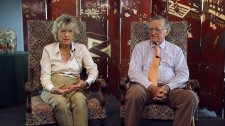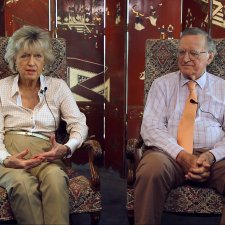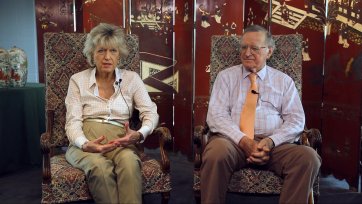Gordon: It all started when I was walking down the gallery at the National Portrait Gallery in Washington. And I kept on recognising the people whose portraits were there. And I finally thought to myself “This is stupid. We could do one of these.” And we decided when we next went to New York for NGA we would call on Alan Fern, the director of the National Portrait Gallery in Washington and ask him one question: “If you were going to start the National Portrait Gallery in Australia, what would you do?” And Alan gave us a string of wonderful pointers. He said get the finest locations, borrow the best portraits from galleries, from private sector, and show them in each place with a prominent person opening them. Uncommon Australians, which James Mollison likes to say is the permanent record, is the story of all that as it progressively happened.
Originally, the first portrait of Don Bradman was in the Bradman Museum at Bowral. So I wrote to the Don and said, ‘Would you be prepared to have a second portrait, by Bill Leak, for Uncommon Australians?” And he wrote back and said “Yes”. So Bill turned up at Adelaide airport and got a taxi, gave the address, and when the taxi stopped at the house, the taxi driver said “You can’t get out here, mate. That’s Don Bradman’s house!” Anyway, he did get out, and he made a terrific portrait, which is in Uncommon Australians.
Marilyn: I love the bust of John Yu, who’s a great friend of ours, and you see very seldom good portraits of people in medicine and research and science. And very often they lack context. And John’s, as a pediatrician for so many years, and so eminent, with the little children climbing over him, I think is just a wonderful outcome. It was very stressful for him having it made, because he had to sit in his sunroom with straws up his nostrils for some as he said almost intolerable amount of time absolutely still, while the plaster cast was put over him. And he said he had to go into a zen-like state, to withstand it, until finally the cast was taken off.
Dame Elisabeth was a founding patron of the tapestry workshop here, which was then called Victorian Tapestry Workshop. And we wanted a portrait of her. And it was quite a process. It was a photograph of her, and it was adjusted to make it more painterly. And then it was woven. And it was a real labour of love because the people working at the workshop just adored her.
I remember how pleased we were to get Walter Lindrum from the UK. He had a niece who lived in Melbourne, and so we got the press there, and there was the crate. And Dolly, the niece was there. And the crate was opened, and Dolly dabbed her eyes and said “Oh, Wal, good to see you again”, and of course we got endless press. Because it was always a good story. People say “Well, look what you did etc etc”. And I said “Well it was always a good story and a good cause. And people were interested. And they were interested in people. So you never felt you were pushing a rock uphill.







